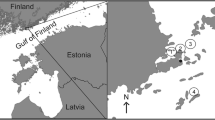Abstract
Coupling between the seasonal phytoplankton growth cycle and resuspension mechanisms in low depth areas was studied. Tidal flood in an estuarine inlet with a large area of intertidal flats was investigated with respect to nutrients and suspended particulate matter, during two different periods of the year. A prespring bloom period in March and another during the productive summer term in August were picked. Results indicate that tidal resuspension mechanisms are important in mobilizing NH4 + from the sediment surface pool, and that this additional input of the limiting nutrient is rapidly consumed in the flooding water column, in benefit of microphytes resident in the nutrient-poor, incoming,coastal waters.
Similar content being viewed by others
References
ALLER, R.C. and Y. YINGST, 1985. Effect of the marine deposit feedersHeteromastus filiformis (Polychaeta),Macoma baltica (Bivalvia) andTellina texana (Bivalvia) on averaged sedimentary solute transport, reaction rates and microbial distributions. J. Mar. Res., 43: 615–645.
AXLER, R.P., G.W. REDFIELD and C.R. GOLDMAN, 1981. The importance of regenerated nitrogen to phytoplankton productivity in a subalpine lake. Ecology, 62: 345–354
BERNER, R.A., 1980. Early Diagenesis: A theoretical approach. Princeton University Press, Princeton, New Jersey. 241 p.
BLACKBURN, T.H. and K. HENRIKSEN, 1983. Nitrogen cycling in different types of sediments from Danish waters. Limnol. Oceanogr., 28: 477–493.
BOON, P.I. and S. CAIN, 1988. Nitrogen Cycling in Saltmarsh and mangrove sediments at Western Port, Victoria. Aust. J. Freshwater Res., 39: 607–623.
CABEÇADAS, G. and M.J. BROGUEIRA, 1991. The Sado estuary, Portugal: eutrophication conditions in areas of aquacultural activities. Environmental Pollution 1. ICEP 1., p. 810–820, Inderscience Enterprises, Ltd.
EPPLEY, R.W., E.H. RENGER and W.G. HARRISON., 1979. Nitrate and phytoplankton production in southern California coastal waters. Limnol. Oceanogr., 24: 483–494.
FANNING, K.A., K. L. CARDER and P. R. BETZER, 1982. Sediment resuspension by coastal waters: a potential mechanism for nutrient recycling in the ocean's margins. Deep Sea Research, 29(8A): 953–965.
FRAPE, S.K. and P.J. PATERSON, 1981. Chemistry of pore-water and bottom sediments as indicators of seepage patterns in Perch Lake, Chalk River, Ontario. Limnol. Oceanogr., 26: 500–517.
GOLDMAN, J.C., J.J. MCCARTHY and D.G. PEAVY, 1979. Growth rate influence on the chemical composition of phytoplankton in oceanic waters. Nature, 279: 210–215.
GRUNDMANIS, V. and J.W. MURRAY, 1977. Nitrification and denitrification in marine sediments from Puget Sound. Limnol. Oceanogr., 22: 804–813.
HOFMAN, P.A.G., S.A. de JONG, E.J. WAGENVOORT and A.J.J. SANDEE, 1991. Apparent sediment diffusion coeficients for oxygen and oxygen consumption rates measured with microelectrodes and bell-jars: applications to oxygen budgets in estuarine intertidal sediments (Oosterschelde, SW Netherlands). Mar. Ecol. Prog. Ser., 69(3): 261–272.
MALONE, T.C., L.H. CROCKER, S.E. PIKE and B.W. WENDER., 1988. Influences of river flow on the dynamics of phytoplankton production in a partly stratified estuary. Mar. Ecol. Prog. Ser., 48: 235–249.
NIXON, S.W., 1981. Remineralization and nutrient cycling in coastal marine ecosystems. In B. Neilson and L. Cronin, Eds., Estuaries and Nutrients. Humana Press, Clifton, New Jersey, p. 111–138.
PINCKNEY, J. and R.G. ZINGMARK, 1991. Effects of tidal stage and sun angles on intertidal benthic microalgal productivity. Mar. Ecol. Prog. Ser., 76(1): 81–89.
RIBEIRO, M.M.C. and R.J.J. NEVES, 1982. Caracterização hidrográfica do rio Sado. SEOA/SEA. (2 Vols.). Lisbon.
ROCHA, C., 1991. Estudo e caracterizaçãso quimica do estuário do Sado — Esteiro da Comporta e Baía de Setúbal. Graduation report. FCUL/INIP, Lisbon.
SOLORZANO, L., 1969. Determination of ammonia in natural waters by the phenolhypochlorite method. Limnol. Oceanogr., 14: 799–801.
SÜNDBACK, K. and W. GRANÉLI, 1988. Influence of microphytobenthos on the nutrient flux between sediment and water: a laboratory study. Mar. Ecol. Prog. Ser., 43: 63–69.
SUTTLE, A.S., J.A. FURHMAN and D.G. CAPONE, 1990. Rapid ammonium cycling and concentration dependent partitioning of ammonium and phosphate: Implications for carbon transfer in planktonic communities. Limnol. Oceanogr., 35(2): 424–433
THOMAS, W.H., 1970. Effect of ammonium and nitrate concentration on chlorophyll increases in natural tropical Pacific phytoplankton pop ulations: Limnol. Oceanogr., 15: 386–394
Author information
Authors and Affiliations
Rights and permissions
About this article
Cite this article
Rocha, C., Cabeçadas, G. & Brogueira, M.J. On the importance of sediment-water exchange processes of ammonia to primary production in shallow areas of the Sado estuary (Portugal). Netherlands Journal of Aquatic Ecology 29, 265–273 (1995). https://doi.org/10.1007/BF02084224
Issue Date:
DOI: https://doi.org/10.1007/BF02084224




